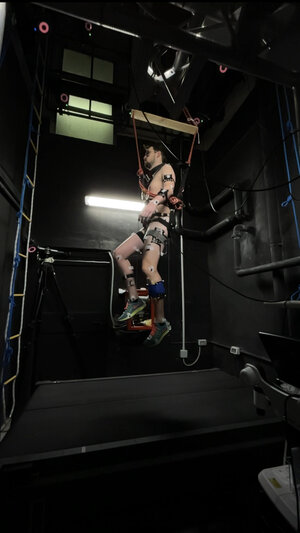Get ready to bounce. Bouncing around on the Moon not only sounds like a lot of fun, but it could also be good for astronaut's muscles, bones and the cardiorespiratory system.
The "Movement in Low gravity environments" (MoLo) programme from ESA’s space medicine team at the European Astronaut Centre (EAC) in Cologne, Germany, aims to test movements in simulated reduced gravity, called hypogravity, on Earth.
This picture shows the first data collection stage of the MoLo study. A 17-metres refurbished ventilation shaft in ESA’s ground based facility “Locomotion On Other Planets” in Milan, Italy, is fitted with a bungee rope suspension system, which allows 6-metres high jumps to be performed. The study team consisting of experts from EAC, the German Sport University in Cologne, the Aachen University of Applied Sciences in Germany, the University of Bath in the UK and the University of Milan in Italy in addition to the German Aerospace Center DLR in Cologne, Germany, is evaluating the movement and balance of each test subject as they jump and perform various other forms of locomotion.
The small blue devices on the participant’s legs are electromyography (EMG) sensors used to measure muscle activity. The grey reflective markers placed on the test subject’s body allow for a full 3D motion analysis to reconstruct the participant’s body in software and analyse their movements.
The next step of the study will happen during a parabolic flight, a flight manoeuvre simulating lunar and Mars-like gravity. During the rollercoaster flight all body parts are affected equally, allowing the team to study the effects of hypogravity on human balance.
If the study reveals that balance is impaired due to reduced gravity levels, the findings will help provide insights that could be used to define effective countermeasure systems to prevent falls and balance problems on the lunar and Martian surfaces.
In a future step, the MoLo study team seeks to also test if hopping can be performed on the International Space Station where loading applied to the body is around 70% of that on Earth.
Hopping could be an additional and effective simple exercise to help astronauts mitigate or prevent deconditioning of muscles and bones that occurs when mechanical forces acting on the human body are reduced when living and working in space.
It could also provide an important aerobic exercise without the need for additional equipment even though astronauts will walk around on the lunar surface during Moonwalks as part of their normal daily tasks.
For further testing on Earth, the MoLo team is involved in developing a system for the ESA-DLR LUNA facility with a vertical suspension system that can suspend two people simultaneously and simulate a moonwalk under simulated hypogravity conditions.
With this pioneering project, the team is looking forward to expanding and pooling knowledge on the effects of hypogravity on the human body to prepare astronauts for future planetary exploration missions.



 Image:
A participant of the Movement in Low gravity environments (MoLo) programme from ESA’s space medicine team at the European Astronaut Centre in Cologne, Germany, testing movements in simulated reduced gravity, called hypogravity, on Earth.
Image:
A participant of the Movement in Low gravity environments (MoLo) programme from ESA’s space medicine team at the European Astronaut Centre in Cologne, Germany, testing movements in simulated reduced gravity, called hypogravity, on Earth.